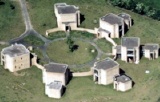EPSRC Symposium Capstone Conference
Mini Symposium on Future Directions in Molecular Simulation
Organiser: Mike Allen
Thursday 2 July 2009
Speakers
Marjolein Dijkstra (Utrecht) Do smectic nuclei exist?
The smectic phase is a well-known liquid crystalline state of matter in which elongated particles form parallel stacks of fluid-like layers. However, the formation of a smectic phase and the nature of the transient structures (clusters, nuclei, droplets) are still a mystery. Whereas the existence of gas-bubbles in a superheated liquid, liquid droplets in a supersaturated gas, or crystallites in an undercooled liquid are undisputed transient structures, there seems to be no analogue for smectic clusters: simple transient smectic droplets have never been observed to the best of our knowledge. Using computer simulations, we have studied the formation of the smectic phase in suspensions of colloidal hard rods and in mixtures of rods and non-adsorbing polymer. We find that the nucleation of the smectic phase is hampered for pure rods due to slow dynamics as the density of the isotropic fluid phase is very high. When polymer coils are added to the suspension, an effective attraction between the rods is induced and we observe nucleation and growth at relatively high supersaturation. More suprisingly, perhaps, we observe that the critical nucleus consists of a single layer of rods and that multiple layers of the smectic phase are formed only due to coalescence of single layers of rods.
In addition, we study the stability of orientationally disordered crystal phases in a suspension of colloidal hard dumbbells using Monte Carlo simulations. We find that the plastic crystal with the hcp structure is more stable than the fcc structure, while it is well-known that for hard spheres the fcc structure is more stable. In addition, we find that the orientationally disordered aperiodic crystal structure is a stable phase in the phase diagram. Moreover, we determine the phase behaviour of colloidal shells (bowls) and we find a remarkably rich variety of liquid crystalline phases as a function of the thickness of the shells. We compare our results with experiments on colloidal dumbbells and colloidal shells.
Alessandro Troisi (Warwick) An unexpected application of classical molecular simulations: understanding the quantum dynamics of the electrons in soft materials Co-Authors: D. Cheung, D. McMahon (University of Warwick), D. Andrienko (MPIP - Mainz)
The charge dynamics in many soft materials (semiconducting polymers and liquid crystals) is controlled by the nuclear dynamics and an efficient evaluation of the latter is now recognized as one of the most difficult tasks toward the prediction of the electronic properties of these materials. We present two recent examples of our method to predict the charge mobility based on a combination of classical and quantum simulations: (i) the P3HT polymers in the crystalline phase and the electronic traps induced by his conformational dynamics, (ii) the charge dynamics in a columnar liquid crystal where a model based on Langevin dynamics can be used to extract the charge mobility.
Richard Vink (Göttingen) Monte Carlo simulations of fluids with quenched disorder
It is well known that the liquid-gas transition in a fluid belongs to the universality class of the Ising ferromagnet. This means that critical exponents measured in a fluid are identical to those of the Ising model, even though the systems are obviously very different. In this presentation, I will discuss the more complicated problem of a fluid mixture consisting of mobile particles and immobile ones. As it turns out, the universality class of such a system is that of the random-field Ising model.
Nigel Wilding (Bath) Simulations studies of polydisperse crystals
Many complex fluids are polydisperse, that is they comprise mixtures of similar rather than identical constituents. Examples are colloidal dispersions in which the particles may exhibit a spread of sizes, shapes or surface charges, or polymers which may have a range of chain lengths. In this talk I will outline some of the interesting effects polydispersity can have on bulk phase behaviour. I will then describe the computational challenges posed by polydispersity and describe new Monte Carlo simulation algorithms that allow the phase behaviour of polydisperse systems to be tackled effectively. Simulations results for the influence of size polydispersity on the crystalline phase of soft spheres will then be presented. Polydispersity is seen to give rise to pronounced changes in the melting properties and to the appearance of multiple coexisting fcc solid phases at high densities.
See also:
Mathematics Research Centre
Mathematical Interdisciplinary Research at Warwick (MIR@W)
Past Events
Past Symposia
Where possible, visitors should obtain an EDUROAM account from their own university to enable internet access whilst at Warwick.
You can register for any of the symposia or workshops online. To see which registrations are currently open and to submit a registration, please click hereLink opens in a new window.
Mathematics Research Centre
Zeeman Building
University of Warwick
Coventry CV4 7AL - UK
E-mail:
MRC@warwick.ac.uk

